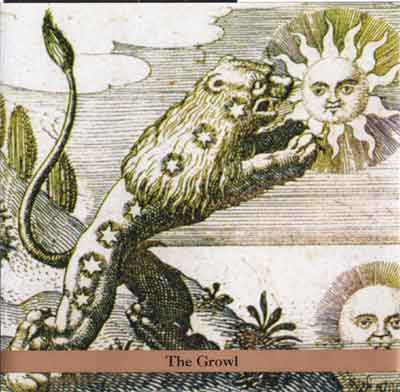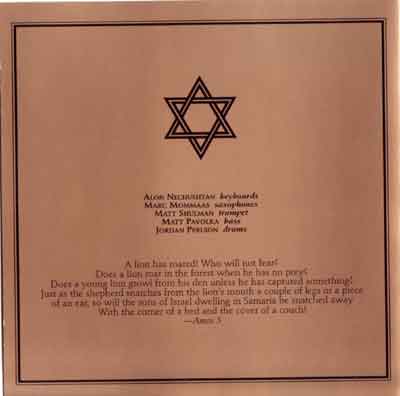TALAT




1/ The Growl: Unwrapped/The Growl/Spielman (Nechushtan) 9.27
Dreams/Storm Among the Pines
2/ Romanseiro (River of Tears) (Nechushtan) 5.22
3/ Hasidic Monk (Nechushtan) 5.28
4/ Pseifas (Nechushtan) 3.58
5/ Ma'agel (Nechushtan) 7.51
6/ Loa'madon (Nechushtan) 5.32
7/ Sh'aq (Nechushtan) 3.41
8/ Tikkun Olam (Ladder to the Rainbow) (Nechushtan) 3.50
9/ Tzahor (Nechushtan) 1.57
10/ Shoham (Nechushtan) 8.55
Recorded at ????
Engineered by Marc Urselli
Mixed at Orange Music Studios, West Orange, New Jersey
Engineer at Orange Music: Robert Musso
Assistant at Orange Music: James Dellatacoma
Mix Translation: Bill Laswell
Produced by Alon Nechushtan
Executive Producer: John Zorn
Mastered by Scott Hull
Alon Nechushtan: keyboards; Matt Shulman: trumpet; Jordan Perlson: drums; Matt Pavolka: bass;
Marc Mommaas: saxophone.
2006 - Tzadik (USA), TZ 8113 (CD)
The nine-minute opening title track begins with what at first seems an incoherent blend of sounds, but it soon evolves into a Middle Eastern-inspired groove that showcases saxophonist Marc Mommaas and trumpeter Matt Shulman, who explores the upper register of his instrument as much as the melody allows.
“Romanseiro (River of Tears)" begins with a soft piano, but then the rhythm evolves into an Eastern European-meets-regional Italian feel. “Pseifas" initially a feature for bassist Matt Pavolka, is a straight, Brubeck-esque tune, evidence that the musicians spent a lot of time listening to the veteran pianist's band during its years with Paul Desmond.
The only unsuccessful track is “Hasidic Monk", which relies too much on Israeli-inspired sounds without enough space to expand within its format. The listener can feel the album’s contrast in moments such as “Loa Madon", which begins with a swinging bass line that is later expanded to the whole group.
The quintet has compelling chemistry in abundance, a fact that's clear on one of the album's best moments, the bluesy “Sh'aq" on which leader Alon Nechushtan switches to B-3 and directs the group in a call-and-response segment, then moves them into a free-form section. This kind of fluidity cannot be accomplished unless solid relationships are encouraged and formed between musicians.
Ernest Barteldes (courtesy of the All About Jazz website)
You're in a cafe and you realize you're no longer paying any attention to your friend. Your focus has shifted to the obscure jazz playing on the crackly speakers in the corner. You make a mental note to ask the guy behind the counter about the artist, but you completely forget until you've been home for an hour. The Growl by NYC-based quintet Talat is everything I expect from such esoteric coffeehouse ghosts - alluring, cerebral, technically impressive, all the while maintaining an air of calmness that makes it perfect background for good conversation over good java.
Talat plays a lively, horn-heavy brand of jazz. Their roots are firmly and fundamentally planted in bebop, but their deep Jewish influences push them into unique territory. Though Talat has yet to become a household name, they have caught the attention of respected players from within the music world. Avant-garde composer and legendary instrumentalist John Zorn directed and produced The Growl, which was mixed by the equally legendary Bill Laswell, whose exceptional career has spanned from Herbie Hancock to Praxis.
Talat's popularity will surely benefit from Zorn's and Laswell's stamps of approval but their music has no need for name-dropping. The Growl was entirely composed by keyboardist Alon Nechushtan. The horn section - Marc Mommaas (saxophones) and Matt Shulman (trumpet) - keep things lively and maintains a commanding presence throughout. Bassist Matt Pavolka and drummer Jordan Perlson create intricate backbeats with complex shifts in each piece. Perlson, in particular, shines on nearly every cut, his drum presence the backbone of this quintet. The Growl runs just under an hour, but within those few minutes lie enough to satisfy any jazz fanatic for months. The beautiful title track leans heavily on Shulman's trumpet then incorporates each player with ease. The extended melody invites the listener into the world of Talat. Another highlight is "Hasidic Monk," which contains a tribute to Dizzy Gillespie's genre-defining "Salt Peanuts." The opening organ on "Sh'ag" flawlessly flows into the horns then becomes a fast, funky composition. The most experimental track is closer "Shoham," a no-holds-barred approach to jazz with a superb drum solo and a finish akin to Miles Davis' Aura.
There really isn't a standout amongst these five musicians. Their interplay is seamless, and their music is a hybrid of Jacob Fred Jazz Odyssey, Golem, and the Soulive. But even that wide range doesn't do them justice. Talat is classy jazz with an adventurous spirit and not a shred of pretension. Talat has a real creation on their hands, and they deserve to be heard.
Trevor Pour (courtesy of the Jambase website)